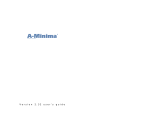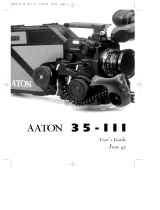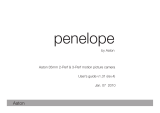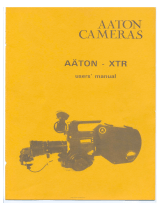Page is loading ...

THE MAGAZINE
57
3
USER 16 US.sept 6/12/97 17:29 Page 57

3.1 CONCEPT
The Aaton DX Magazine incorporates many features which add to
the camera system's ease-of-use, efficiency and reliability. The
magazine's coaxial design allows for separate feed and take-up
chambers, which ensures that the bulk of the loading process is
performed in daylight.
The DX Magazine is driven magnetically from an intermediate drive
connected to the camera motor; a magnetic wheel on the inner side
of the camera body couples with a similar wheel on the throat of the
magazine to transport the film. This magnetic drive system decreases
noise and power consumption, and prevents mechanical stress
during mis-loads.
The magazine handles up to 400 ft (122m) loads of double or single
perforated 16mm film stock. 400 feet of film is approximately 10.5
running minutes at 24 fps.
3.2 COMPATIBILITY
3.2.1 DX Magazines
Since the introduction of the XTR in 1984, only DX magazines
have been manufactured by Aaton, all of which can be used on
today's XTRprod (approximate ser #3500 and above). The DX code
distinguishes this magazine from earlier designs. D refers to its
emulsion-out Super16-safe coaxial roller (further explained below).
X refers to its magnetic drive system.
3.2.2 Super16 Safe
All DX magazines are designed to safely transport either standard or
Super16 stock. Capped rollers keep the running film from riding up
and prevent any contact within the picture area. The mag's large
coaxial roller, which transports the film from the feed into the take-
up chamber, handles the film on its less-sensitive base side and
facilitates a long and twistless film path. (Severe twisting of the more
58
USER 16 US.sept 6/12/97 17:29 Page 58

sensitive high speed stocks, as is the case with the LTR and some
other manufacturers' magazines, has been known to cause grain
fracturing and a resulting abnormal exposure of the film in that
area.)
3.3 PRESSURE PLATE SYSTEM
The DX magazine features two pressure plates which are located at the
front of the nose of the magazine. When the loaded magazine is
attached to the camera, these pressure plates provide the precise
stabilization of the film during exposure and transport.
3.3.1 The Picture Plate
The upper four-striped pressure plate, called the picture plate, is
positioned at the camera's aperture opening and is designed to hold
the film steady at the point of exposure. Proper setting and
functioning of the picture plate assures the precise focus of each
image.
59
THE MAGAZINE
USER 16 US.sept 6/12/97 17:29 Page 59

3.3.2 The Claw Plate
The lower plate, called the claw plate, is positioned at the pulldown
claw and functions to stabilize the film as the claw engages the film
perf between exposures. Proper tension and functioning of the claw
plate contribute to reliable transport and quiet operation.
3.4 MAG IDENTIFICATION SYSTEM
3.4.1 Mag ID
Each DX magazine bears its own identification (ID) determined by
the combination of magnets in receivers located above the drive
wheel on the throat of the mag. This identification is used by the
camera to recall the remaining footage of a mag removed from the
body unfinished. The XTRprod can differentiate seven magazines (A
through G) via electronic sensors located within the LCD control
panel and recall the memorized footage for each. By comparison, the
less sophisticated display of the XTRplus can identify only three
magazines (A, B, C).
The chart to the right represents the seven IDs which can be read by
the XTRplus and XTRprod cameras, with the corresponding
magnet in receiver combination for each.
3.4.2 Changing the ID of a Magazine
The Mag ID of a particular magazine can be easily changed by the
user. Determine the magnetic receiver(s) that need to be changed
according to the chart above. Locate the small silver spanner tool
located on the coaxial roller in the feed side of the mag. Using this
tool, loosen and remove these receiver(s). A spare receiver is located
at the base of the coaxial roller. Install the appropriate receivers as
necessary. Remember to change the letter decal on the outside of the
feed side door to match the new ID. For spare decals, contact your
Aaton representative.
60
ID of Mags on XTRplus
vs XTRprod
As mentioned, the XTRprod
can distinguish seven
magazines because its sensors
can read all three receivers.
The XTRplus, however, can
only distinguish three
magazines, as its sensors will
only detect the two upper
receivers. Be aware of this
fact when renting additional
magazines. For example, a
mag which is read as a G on
an XTRprod will be read as a
C on an XTRplus camera; as
the lower receiver will not be
detected.
magnet
no magnet
A
B
C
D
E
F
G
USER 16 US.sept 6/12/97 17:29 Page 60

3.5 LOADING
The straightforward design of the DX magazine allows for quick, easy
loading and an absolute minimum amount of threading in the dark.
The film does not need to be cut in preparation for loading.
3.5.1 Feed Side - In the Changing Bag
• Place the film can and the magazine, feed side up, in the changing
bag and zip closed.
• Disable the mechanical footage counter, located on the feed door,
by rotating counter clockwise until it locks in its recessed position.
• Unfasten the feed door lock by turning downward and open the
feed door.
• Remove the film from its can and bag.
• On the feed core holder, squeeze the core lock mechanism on
either side with thumb and forefinger to release core lock.
• Place the film on the feed spindle with its wind clockwise and
press the center of the core lock to lock the core in place.
• Thread 4" of film around the outside of the lower guide roller and
through large coaxial roller emulsion out. Make sure that the length
of film feeds completely through to the take-up side.
61
THE MAGAZINE
Care for your Changing
Bag
A clean and light-tight
changing bag is the only thing
separating your precious
footage from a veritable
washout. Before using your
changing bag each day, turn it
inside out and shake it clean
of dirt and debris. It is also a
good practice to periodically
inspect its edges for holes and
tears. Hold it up to a strong
light to check for any pin hole
leaks.
aimants
USER 16 US.sept 6/12/97 17:29 Page 61

• Close and lock the feed door and engage the footage counter by
rotating clockwise.
• Remove the magazine from the changing bag.
3.5.2 Take-up Side - In Daylight
• Unfasten the take-up door lock by rotating downward and open
the door.
• Release the doors of the upper and lower pinch rollers by pressing
the white buttons and gently pulling open.
• Pull the length of film from the slot of the coaxial roller and pass
below the first idler roller. Bypass the upper sprocket for the time
being and push the film directly through the upper channel slot to
the outside of the nose. Pull through about one foot in length.
• Reintroduce the film into the lower slot, back into the magazine.
• Place a plastic take-up core onto the take-up spindle, check that
the core is seated properly, and press the center of the core lock to
lock the core in place.
• Bypass the lower sprocket for now and pass the film underneath
the lower roller. Fit the film end into a plastic take-up core and
wind on a few turns counter-clockwise and emulsion in.
• Thread the film around the lower sprocket, making sure the film's
62
USER 16 US.sept 6/12/97 17:29 Page 62

perforations engage the sprocket teeth. Close the lower pinch roller
until it locks firmly in position and a noticeable click is heard.
• Hold the lower sprocket with your right thumb and rotate the
take-up core counter-clockwise to remove any slack.
• Thread the film around the upper sprocket and adjust the loop
until its taut length is 14 to 15 frames long outside of the nose.
When the proper length is achieved, close the upper pinch roller
until it locks firmly in position.
• Remove any slack, then close and lock the take-up door.
63
THE MAGAZINE
The Two-Finger Rule
When loading the take-up side
of the magazine, the loop size
can quickly be measured by
inserting two fingers within
the loop perpendicular to the
mag's pressure plates.
At first, determine proper loop
size by pulling the looped film
away from the mag, counting
and adjusting for 15 to 16
visible perforations for a length
14 to 15 frames long. Then,
insert two fingers and check
how the spacing relates to the
proper loop length. Of course,
each person's finger-measured
equivalent will be slightly
different, but for most people,
a tight two-finger length is
approximately a 14 frame
loop, a loose two fingers is
about 15 frames. After you
become familiar loading the
mag, you should be able to use
the two-finger method to save
time setting your loop.
USER 16 US.sept 6/12/97 17:29 Page 63

USER 16 US.sept 6/12/97 17:29 Page 64

THE AATON SYSTEM
65
4
USER 16 US.sept 6/12/97 17:29 Page 65

4.1 CAMERA CONFIGURATIONS
4.1.1 15mm Front Rods
The most versatile and popular configuration for accessorizing the
XTRplus camera, the universal 15mm screw-in front rod system can
instantly accept Aaton, Arri, Chrosziel, Petroff and other
manufacturers' mattebox and follow focus systems. Utilizing the
front rod system allows for quick conversion from tripod to
shoulder operating modes without the need for recon-figuration.
Aaton manufactures 60mm and 120mm length rods that screw
directly into the front housing of XTRprod underneath the lens
port.
The 15mm front rod system is recommended when standard size
lenses and accessories are to be used or when quick conversion
between tripod and handheld modes is necessary.
4.1.2 Sliding Bridgeplate
The XTRprod can also accept standard 15 and 19mm sliding
bridgeplates for building the camera system for high-end studio
work. The bridgeplate configuration can accept Aaton, Arri,
Chrosziel and other manufacturers' mattebox, follow focus and
66
USER 16 US.sept 6/12/97 17:29 Page 66

support equipment that is designed for bridgeplate use.
Standard bridgeplates from Aaton, Arri and other manufacturers can
be attached to the XTRprod by means of the 3/8-16 tripod
recepticle on the underside of the camera.
The sliding bridgeplate system is recommended when large 35mm
lenses and accessories are to be used, when using a geared head or
when the highest possible production value is neccessary.
4.2 HANDGRIP
The XTRprod body includes a wooden handgrip, short 15mm rods, rod
coupler and Lemo2 cable as standard. The handgrip, which is designed
to be used for comfortable handheld operation, can also be used to
provide on/off control on the battery side of the camera while on the
tripod.
4.2.1 Mounting the Handgrip
Screw in one 15mm short rod into each of the two recepticles on
the front housing of the camera below the lens port. Slide the
coupler over the two rods to the desired location and fasten its
center wing nut to secure the rods in position. Attach the handgrip
to the coupler by mating the star plate on the coupler to that on the
handgrip, adjusting to the desired position and fastening the T
screw of the handgrip. Connect the Lemo2 cable between the
handgrip and camera body to add on/off capability to the handgrip.
The Lemo2 connector is located on the battery side of the camera at
the front of the accessory box.
4.2.2 Handgrip On/Off Functions
Both camera run and test functions are available from the handgrip.
While hand-holding the camera, pressing the rocker switch to the
right provides camera run, pressing the switch to the left provides
test. Unlike the body switch, the camera test position of the
handgrip is a momentary switch. Pressing and holding the switch
opens the shutter and advances the mechanism 1/2 frame. Pressing
67
THE AATON SYSTEM
USER 16 US.sept 6/12/97 17:29 Page 67

and immediately releasing this switch advances the mechanism one
full frame at a 1/4 sec exposure time. This function allows the use of
the handgrip as a simple intervalometer.
4.2.3 Handgrip Adjustments
The handgrip rotation should be adjusted for maximum handheld
operating comfort. Loosen the T screw and rotate the handgrip at
the star plate until a more comfortable position is found.
If a more extreme repositioning is required, whether it be for reasons
of comfort or clearance in certain studio rig configurations, this can
be achieved with coupler extenders, spacers and intermediate arms
which utilize the star plate system for adjustment. Ask your agent
for a configuration that meets your needs.
4.3 TRIPOD USE
In order to use the XTRprod on a standard tripod, the tripod's
quick release plate must be fastened to the underside of the camera
body with its standard 3/8-16 screw. Make sure to use only a quick
release plate screw provided by the manufacturer; non-standard
screws longer than 8mm (1/3") can fracture the base casting and
damage the camera's electronics.
4.4 SHOULDER OPERATION
One of the most attractive features of the Aaton system has always
been its comfort and ease of use in handheld situations.
The XTR line does not require the use of shoulder braces or
additional padding for handheld operation. The contour of the
camera and magazine is designed to fit snugly around the operator's
shoulder. The wooden handgrip is attached to the front rod coupler
at a slight angle to bring the operator's elbow into his side and
increase stability.
68
USER 16 US.sept 6/12/97 17:29 Page 68

The system can be completely built off the 15mm front rods
without the use of a bridgeplate to allow for quick changing from
shoulder to tripod operating modes.
4.5 CARRYING HANDLE
The carrying handle of the XTRprod is reinforced to safely accommodate
any carrying, operating or mounting situation.
4.5.1 3/8 Accessory Screw
The handle features a 3/8-16 insert to receive accessories such as
french flags and lightweight monitors. Be sure not to use a 3/8 screw
longer than 10mm (7/16"); longer screws can fracture the insert
casting and damage the viewfinder's optics.
4.5.2 Mounting from the Carrying Handle
The 3/8 insert, along with a guide hole at the rear of the handle, can
also be used to build a plate to undersling the camera or to
configure the rig for Steadicam low mode use. For this reason, the
handle features a long flat top surface that is parallel to the bottom
of the camera.
69
THE AATON SYSTEM
USER 16 US.sept 6/12/97 17:29 Page 69

4.5.3 Tape Measure Stud
The handle is also equipped with a hideaway tape measure stud,
which is positioned between the rods directly behind the 3/8 insert.
To use this stud, pull it up and fasten the ring of a standard
assistant's tape measure around it; the stud holds the tape measure
zero point precisely at the film plane.
4.6 TRANSPORT
One often overlooked, yet vital factor in the proper functioning and
longevity of your camera equipment is your transportation practices. A
few good shipping habits can avert potential damage caused by careless
messenger services and airport handling.
When shipping and carrying your equipment, it is always good
practice to break down the package to its basic components
whenever possible. Ship the body, mags and batteries unattached
and individually padded. Never, under any circumstances, ship the
camera with a lens attached (especially a zoom lens). Shocks
transferred from the outside of a case could have disastrous effects to
the ultra-critical back focus of a lens and flange focal distance of a
camera if transported as one.
70
USER 16 US.sept 6/12/97 17:29 Page 70

Make certain there is ample padding between individual
components in a case and from the case's outer edges. Shipping case
manufacturers suggest a minimum of 1 1/2" padding between high
precision components such as the camera and lenses. 1" of padding
is acceptable, however, between some of the more rugged
components, such as magazines and batteries. Manufacturers also
suggest to allow 2" of padding between the component and the
outside of the case.
Choose a case design that, not only meets your shipping and travel
requirements, but allows you maximum flexibility and comfort out
in the field. Check with your Aaton agent to determine the case
configuration that best suits your needs.
4.7 EXTREME CONDITIONS
Certain precautions should be taken in order to achieve maximum
performance when operating the XTRprod in extreme or adverse
conditions.
4.7.1 Cold weathers
The XTRprod features a built-in electronic heating element located
in its base which is designed to automatically turn on when needed
and maintain the claw mechanism at a temperature of 15° F.
One of the cold, hard facts of cold weather shooting is the
considerable reduction of battery life. Do whatever possible to
conserve your batteries and always carry more than usual. Favor
many small batteries, such as on-boards and lithium cells (which are
easier to keep warm), over large block batteries. Use a powercable so
that the on-board battery could be kept in a pocket close to the
warmth of your body.
When filming outdoors, use a standard or heated barney to protect
the camera body from direct contact with the wind and cold. To
avoid condensation inside the mechanism, electronics and lens
elements, do not take the equipment indoors or expose it to sudden
71
THE AATON SYSTEM
USER 16 US.sept 6/12/97 17:29 Page 71

temperature changes. If and when the equipment must be moved
inside, do so by first placing it in a sealed container and letting it
thaw for a few hours before opening.
Always keep your raw stock and loaded magazines below freezing
temperatures at all times during a cold weather shoot.
7.2 Warm Weather
To keep the temperature of the camera body down, avoid having the
camera exposed to direct sunlight for long periods of time by using a
barney, all-weather cover, or some form of shading, like an umbrella.
Most importantly, keep raw stock and magazines in a dry cooler or
in the coolest location available.
72
USER 16 US.sept 6/12/97 17:29 Page 72

73
THE AATON SYSTEM
USER 16 US.sept 6/12/97 17:29 Page 73

USER 16 US.sept 6/12/97 17:29 Page 74

CLEANING
75
5
USER 16 US.sept 6/12/97 17:29 Page 75

5.1 LENS
5.1.1 Lens Elements
The front and rear surfaces of your lenses should be inspected
regularly and always kept clean of dust particles, smudges,
fingerprints, etc. First, blow off any large particles of debris using an
air syringe. Lens elements should then be cleaned using lens
cleaning fluid with lens tissue. Apply a few drops of cleaning fluid
to a fresh lens tissue or directly to the lens. Wipe the lens in a
circular fashion, starting from the center and working towards the
outer edge. Finish with a fresh dry tissue. If some streaking remains,
repeat the procedure until the surface is sufficiently clean.
5.1.2 Lens Exterior
The exterior of your lenses such be cleaned of dirt and adhesives as
necessary. Use a multi-purpose cleaner or degreaser such as De-Solv-
It applied with a Q-tip, lens tissue or cotton cloth.
5.1.3 Mounting Surface
Always inspect and keep the surfaces of your lens mounts clean
using alcohol or a multi-purpose cleaner with a Q-tip. Remember,
any debris found on the surface which contacts the lens seat can
directly affect the back focus of your lens. Make sure the Q-tip does
not leave any cotton fibers behind.
5.2 BODY
5.2.1 Exterior
Keep the external body surfaces clean using a cotton cloth with
alcohol or a multi-purpose cleaner. Use a utility brush with soft
bristles to clean dirt from tight crevices.
5.2.2 Mounting Surfaces
Like the lens mount, extra care should be taken to keep the lens
76
Lens Cleaning Tips
Avoid handling lens tissue on
the surfaces which will contact
the lens. Oil from your hands
transferred to the lens surface
will make an easy cleaning job
tough. Furthermore, never
clean a lens element without
the aid of cleaning fluid. A
good number of scratches on
lens surfaces are caused by
poor cleaning methods.
USER 16 US.sept 6/12/97 17:29 Page 76
/









